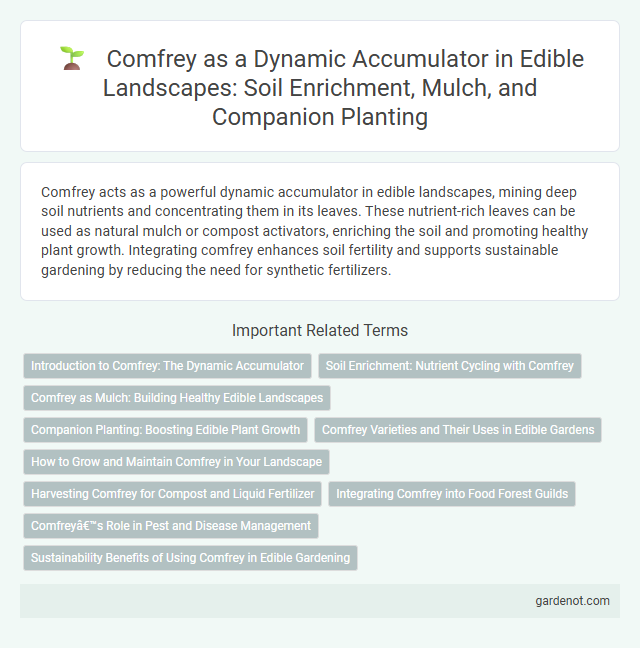Comfrey acts as a powerful dynamic accumulator in edible landscapes, mining deep soil nutrients and concentrating them in its leaves. These nutrient-rich leaves can be used as natural mulch or compost activators, enriching the soil and promoting healthy plant growth. Integrating comfrey enhances soil fertility and supports sustainable gardening by reducing the need for synthetic fertilizers.
Introduction to Comfrey: The Dynamic Accumulator
Comfrey is a highly valued dynamic accumulator in edible landscapes, known for its deep taproot that mines nutrients like potassium, calcium, and nitrogen from subsoil layers. Its large, nutrient-rich leaves decompose rapidly, making excellent organic mulch and compost activator to enhance soil fertility. Gardeners use comfrey to improve soil health, support plant growth, and reduce the need for synthetic fertilizers by naturally recycling essential minerals.
Soil Enrichment: Nutrient Cycling with Comfrey
Comfrey acts as a powerful dynamic accumulator, drawing up essential nutrients like potassium, calcium, and nitrogen from deep soil layers to the surface foliage. When comfrey leaves decompose or are used as mulch, they release these nutrients back into the topsoil, enhancing soil fertility and structure. This nutrient cycling process supports healthy plant growth and reduces the need for synthetic fertilizers in edible landscapes.
Comfrey as Mulch: Building Healthy Edible Landscapes
Comfrey, a dynamic accumulator, excels as a nutrient-rich mulch by drawing minerals like potassium, calcium, and nitrogen from deep soil layers and releasing them slowly as it decomposes. Its thick, fibrous leaves create a protective layer that suppresses weeds, retains moisture, and promotes beneficial microbial activity essential for healthy edible landscapes. Integrating Comfrey mulch enhances soil fertility naturally, supporting robust growth of vegetables, fruits, and herbs in sustainable garden systems.
Companion Planting: Boosting Edible Plant Growth
Comfrey is a dynamic accumulator highly valued in edible landscapes for its ability to mine essential nutrients like potassium, calcium, and nitrogen from deep soil layers, enriching the soil for companion plants. Its deep roots break up compacted soil, improving aeration and water retention, which significantly boosts the growth of neighboring vegetables and fruit trees. Planting comfrey alongside edible plants enhances their nutrient uptake and overall health, promoting vigorous growth and higher yields in sustainable gardens.
Comfrey Varieties and Their Uses in Edible Gardens
Comfrey varieties such as Symphytum officinale and Hungarian Comfrey (Symphytum x uplandicum) serve as dynamic accumulators in edible gardens by mining essential nutrients like potassium, calcium, and phosphorus from deep soil layers. These robust plants enhance soil fertility, support compost systems, and act as green mulch, improving water retention and promoting plant health. Gardeners often integrate comfrey to boost crop yields, enrich soil organic matter, and provide nutrient-rich fodder for livestock.
How to Grow and Maintain Comfrey in Your Landscape
Comfrey, a dynamic accumulator, thrives in well-drained soil with partial to full sun exposure and requires minimal maintenance once established. Regularly harvesting the leaves encourages vigorous growth and prevents the plant from becoming invasive, while applying compost or organic mulch supports nutrient uptake. Deep watering during dry periods ensures healthy root development and maximizes the plant's ability to accumulate minerals for improved soil fertility.
Harvesting Comfrey for Compost and Liquid Fertilizer
Harvest comfrey leaves regularly to maximize nutrient accumulation as they are rich in potassium, calcium, and trace minerals ideal for compost enrichment. Use chopped comfrey foliage to create a nutrient-dense liquid fertilizer by steeping it in water for 2-3 weeks, then dilute before application. Incorporating comfrey into compost piles accelerates decomposition and boosts microbial activity, enhancing soil fertility naturally.
Integrating Comfrey into Food Forest Guilds
Comfrey acts as a powerful dynamic accumulator by mining essential nutrients like potassium, calcium, and nitrogen from deep soil layers, enriching the topsoil for surrounding plants. Its deep taproot improves soil structure and moisture retention, making it an invaluable component in food forest guilds where nutrient cycling and soil health are critical. Incorporating comfrey into guilds supports neighboring fruit trees and shrubs by supplying natural mulch and fostering beneficial microbial activity.
Comfrey’s Role in Pest and Disease Management
Comfrey acts as a dynamic accumulator by drawing essential nutrients like potassium and calcium from deep soil layers, which enhances plant health and resilience against pests and diseases. Its dense foliage serves as a natural mulch, suppressing weed growth and creating a microhabitat that supports beneficial insects, such as predatory beetles and pollinators. This combination reduces the need for chemical pest control in edible landscapes, promoting sustainable and organic gardening practices.
Sustainability Benefits of Using Comfrey in Edible Gardening
Comfrey, a dynamic accumulator, enhances soil fertility by mining essential nutrients like potassium, calcium, and nitrogen from deep soil layers and returning them to the surface through its leaves. Its rapid growth provides abundant biomass for mulching and composting, reducing the need for synthetic fertilizers and conserving resources. The plant's deep roots improve soil structure and water retention, promoting sustainable water use and long-term garden health.
Comfrey dynamic accumulator Infographic

 gardenot.com
gardenot.com